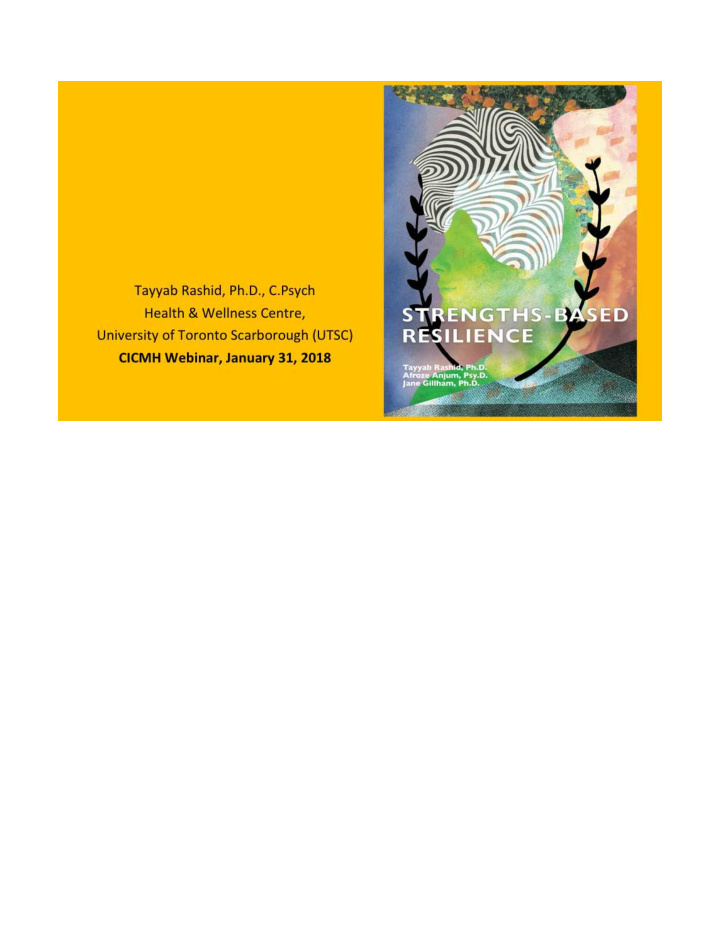



2013 ◦ 32 institutions ◦ 34,039 responses ◦ 20.4% response rate 2016 42 institutions 43,780 responses 19.2% response rate
34,
Keyes CLM. The mental health continuum: From languishing to flourishing in life. Journal of Health and Social Behavior. 2002;43:207–222. doi: 10.2307/3090197 Keyes CLM. Mental illness and/or mental health? Investigating axioms of the complete state model of health. Journal of Consulting and Clinical Psychology. 2005;73:539–548. doi: 10.1037/0022-006X.73.3.539. Keyes CLM. Mental health in adolescence: Is America’s youth flourishing? American Journal of Orthopsychiatry. 2006;76:395–402. doi: 10.1037/0002-9432.76.3.395. Keyes CLM. Promoting and protecting mental health as flourishing: A complementary strategy for improving national mental health. American Psychologist. 2007;62:95–108. doi: 10.1037/0003-066X.62.2.95. Keyes CLM, Shapiro AD. Social well-being in the United States: A descriptive epidemiology. In: Brim OG, Ryff CD, Kessler RC, editors. How healthy are we: A national study of well-being at midlife. Chicago: University of Chicago Press; 2004. pp. 350–373. Keyes CLM, Shmotkin D, Ryff CD. Optimizing well-being: The empirical encounter of two traditions. Journal of Personality and Social Psychology. 2002;82:1007–1022. doi: 10.1037/0022-3514.82.6.1007. Keyes CLM, Wissing M, Potgieter J, Temane M, Kruger A, Rooy S. Evaluation of the Mental Health Continuum—Short Form (MHC-SF) in Swetsana-speaking
South Africans. Clinical Psychology and Psychotherapy. 2008;15:181–192. doi: 10.1002/cpp.572.
http://www.chronicle.com//img/photos/biz/photo_72393_landscape_650x4 33.jpg Connor KM, Davidson JRT. Development of a new resilience scale: the Connor-Davidson Resilience Scale (CD-RISC). Depression and Anxiety, 2003: 18: 71-82. http://www.cd-risc.com/index.php
Baumeister, R. F., Bratslavsky, E., Finkenauer, C. & Vohs, K. D. (2001). Bad is stronger than good. Review of General Psychology, 5, 323-370. Add Reference to Loss Aversive and Gain Sensitive Part: Our brain is still Pleis-to-cean or Glacial one, remember failures, notice when tongue was irritated, when there was a stone in the shoe, when no water in the tap. “Fundamental Negative Bias” Bad emotions, bad parents, bad feedback Bad impressions and stereotypes More loss aversive than gain sensitive Image Source: http://www.tiptoplifestyle.com/wp- content/uploads/2014/06/Negativity-2.png
Human nature has an inherent capacity for Growth, fulfillment, and flourishing 2. Positive Emotions and Traits are Authentic as Symptoms, Competition --- Cooperation Grudges --- Gratitude Hubris --- Humility Insults --- Compliments Indulgence --- Self-regulation Scheel, M. J., Davis, C. K., & Henderson, J. D. (2012). Therapist Use of Client Strengths: A Qualitative Study of Positive Processes. The Counseling Psychologist, 41(3), 392–427. doi:10.1177/0011000012439427
Image Source: http://www.mind-4.com/wp-content/uploads/2016/05/iStock- 493765026.jpg
Rashid, T., Anjum, A., Lennex, C., Quinlin, D., Niemiec, R., Mayerson, D., Kazemi, F. (2013). Assessment of Positive Traits in Children and Adolescents in C. Proctor & P.A. Linley (eds.), Research, Applications, and Interventions for Children and Adolescents: A Positive Psychology Perspective. (pp. 81-114). The Netherlands: Springer.
Source: https://www.michellemcquaid.com/wp- content/uploads/2013/11/binacular8.jpg
https://learningrmps.wordpress.com/tag/inspiring-purpose/ https://images-na.ssl-images-amazon.com/images/I/81KCBVwz7FL.jpg https://learningrmps.wordpress.com/2017/02/22/inspirational-characters- and-people/
Rashid, T. (2015) Strength-Based Assessment, in Positive Psychology in Practice: Promoting Human Flourishing in Work, Health, Education, and Everyday Life, Second Edition (ed. S. Joseph), pp. 519-544. Wiley, Hoboken, NJ, USA.
Schwartz, B., & Sharpe, K. E. (2006). Practical Wisdom: Aristotle meets Positive Psychology. Journal of Happiness Studies, 7, 377-395. Relevance : does a particular situation requires a signature strength or some other strength? e.g., social intelligence vs. Prudence; Conflict: should one be honest or kind? illustrations; e.g., whistle blowing Specificity: translation into concrete actions e.g., specific behaviours; If all you have a hammer, everything becomes nail Integration: Strengths co-exist, kindness & social intelligence, curiosity & love of learning, self- control & modesty…etc. McNulty & Fincham: 1. Examine conditions; 2. Exam both Healthy & Unhealthy people; 3. Study WB longitudinally; 4. Avoid positive or negative labeling For nuanced, dynamic and contexutliazed use of strengths, see McNulty, J. K. & Fincham, F. D. (2012). Beyond positive psychology? Toward a contextual view of psychological process and well-being. American Psychologist, 67, 101-110. Kashdan, T. B., & Rottenberg, J. (2010). Psychological flexibility as a fundamental aspect of health. Clinical Psychology Review, 30, 865 – 878. Biswas-Diener, R., Kashdan, T. K & Minhas, G. (2011). A dynamic approach to psychological strength development and intervention, The Journal of Positive Psychology 6(2), 106-118. Images Sources: Wrong Tool: https://rochemamabolo.files.wordpress.com/2013/12/hammer.png Yin & Yang: http://peakwatch.typepad.com/.a/6a00d83452403c69e201bb07e7894e970d-pi Ingredients: http://careerinterchange.com/wp-content/uploads/2014/09/ingredients.jpg
Recommend
More recommend